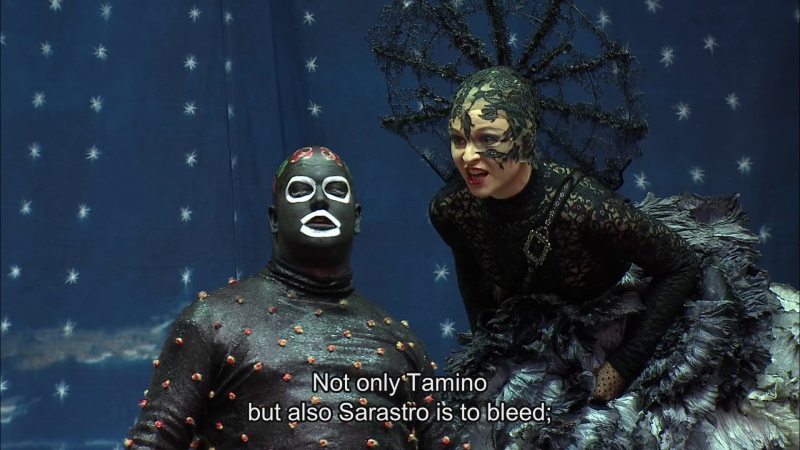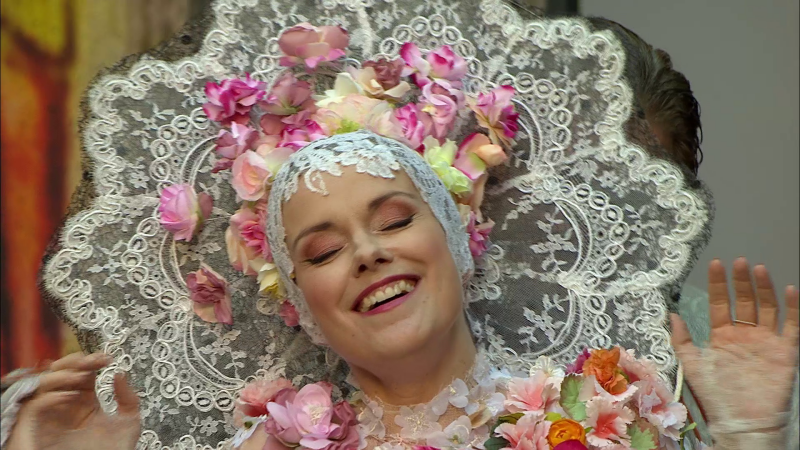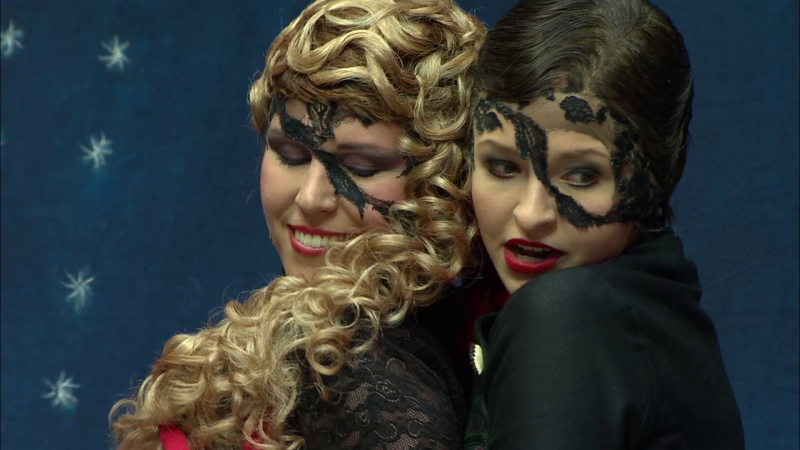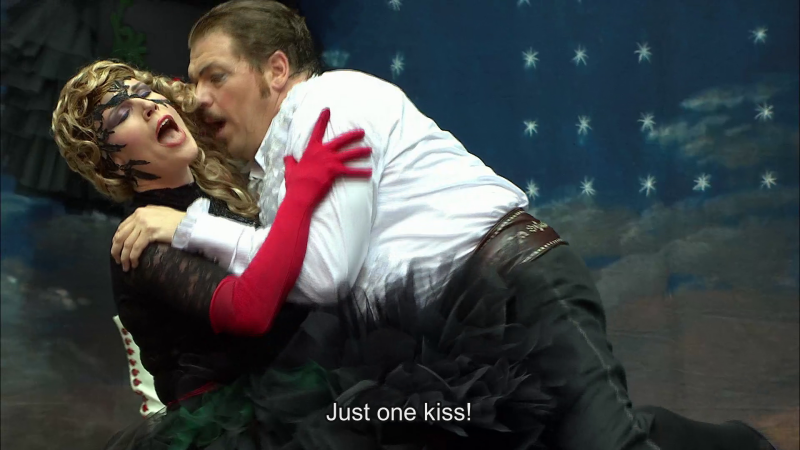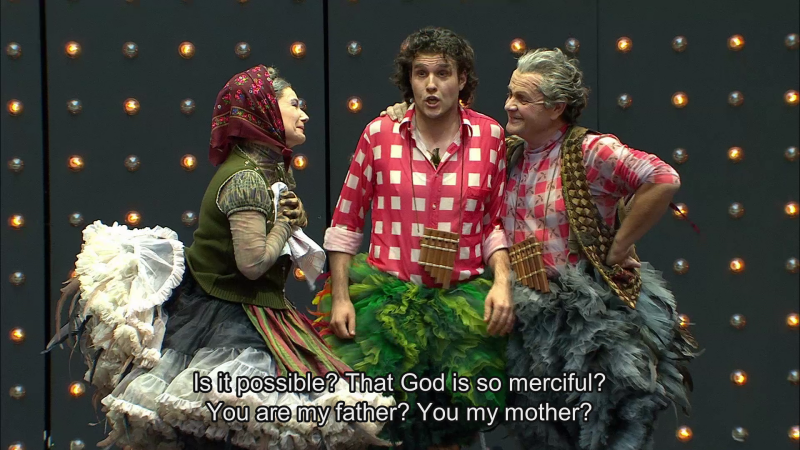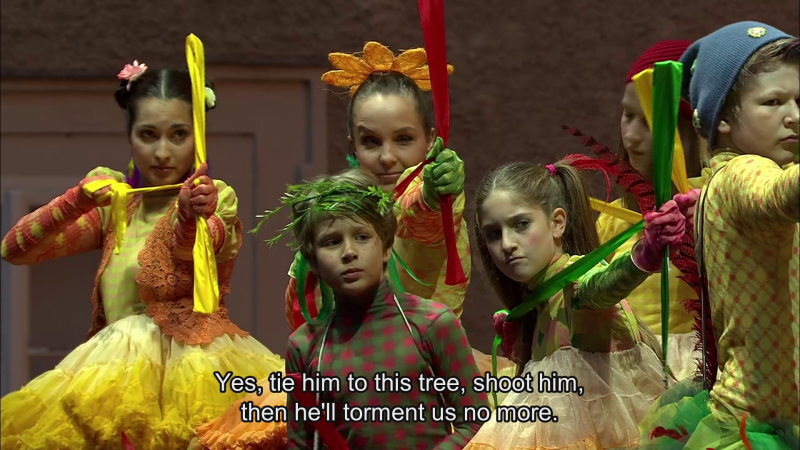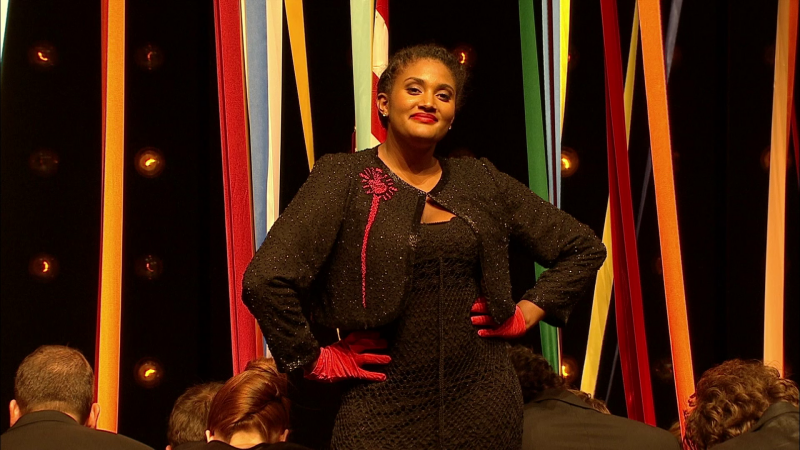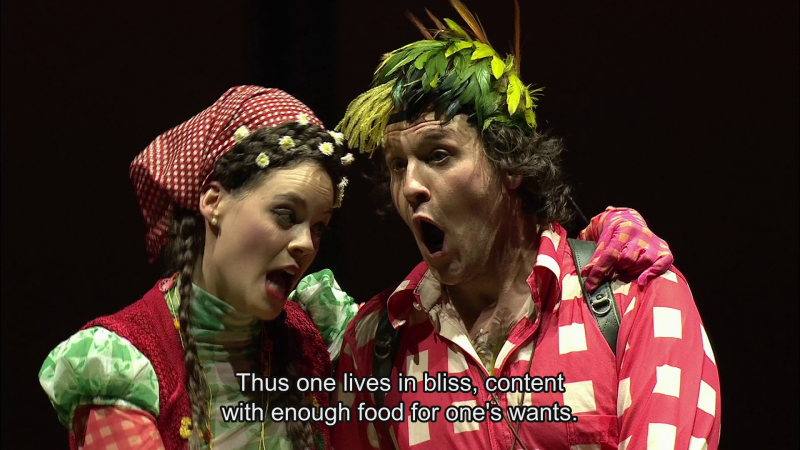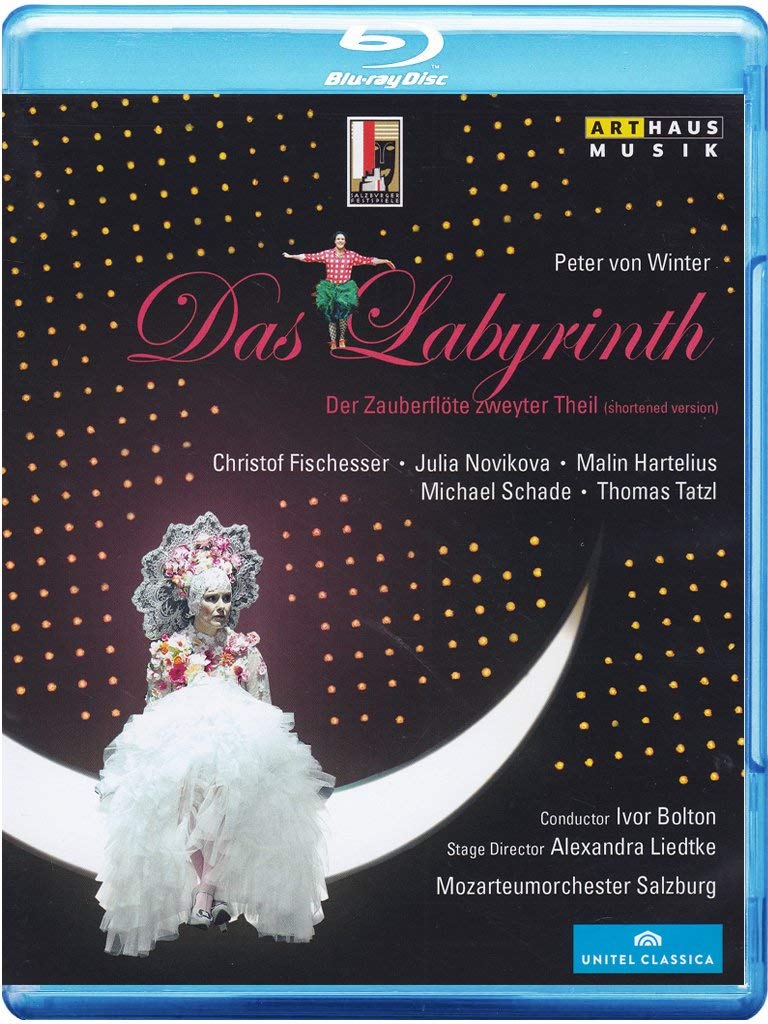
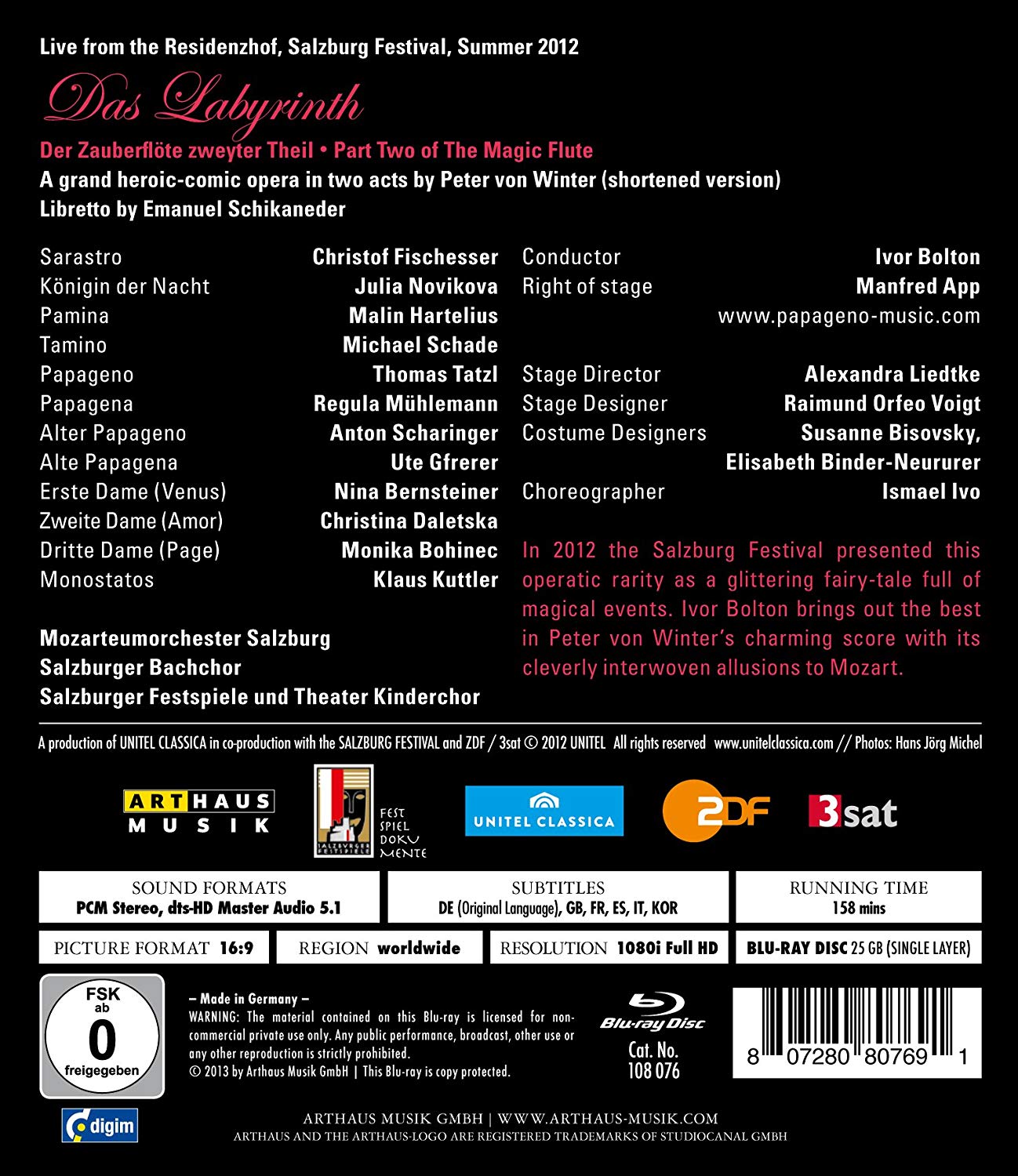
Peter von Winter Das Labyrinth opera to libretto by Emanuel Schikaneder. Directed 2012 by Alexandra Liedtke at the Salzburg Festival. Stars Christof Fischesser (Sarastro), Julia Novikova (Koningin der Nacht), Malin Hartelius (Pamina), Michael Schade (Tamino), Thomas Tatzl (Papageno), Regula Mühlemann (Papagena), Anton Scharinger (Alter Papageno), Ute Gfrerer (Alta Papagena), Nina Bernsteiner (Erste Dame [Venus]), Christina Daletska (Zweite Dame [Amor]), Monika Bohinec (Dritte Dame [Page]), Klaus Kuttler, Clemens Unterreiner, Philippe Sly. Mauro Peter, Manuel Günther, Zoltan Nagy, Paul Schrader, Benedikt Gurtner, Johannes Fiedler, and Shantia Ullmann. Ivor Bolton conducts the Mozarteumorchester Salzburg (piano and glockenspiel by Jeffrey Smith), the Salzburger Bachchor (Chorus Master Alois Glaßner), and the Salzburger Festspiele und Theater Kinderchor (Chorus Master Wolfgang Götz). Set design by Raimund Orfeo Voigt; costumes by Susanne Bisovsky and Elizabeth Binder-Neururer; choreography by Ismael Ivo. Directed for TV by Peter Schönhofer; Director of Photography Nyika Jancsó. Produced by Paul Smaczny of Accentus Music. This recording is a world premiere. Sung in German. Released 2013, disc has 5.1 dts-HD Master Audio sound. Grade: C
Seven years after Mozart's death, Schikaneder promoted Das Labyrinth as a sequel to Die Zauberflöte. Sarastro, the Queen of the Night, Tamino, Pamina, Papageno, Papagena, the Three Ladies, and Monostatos are all back, plus there are new characters.
You will recall that at the end of Die Zauberflöte, Sarastro had defeated the Queen of the Night (who retreated to her castle) and that there would soon be weddings for Tamino/Pamina and Papageno/Papagena. As Das Labyrinth opens a few day after Sarastro's victory, the Queen and Monostatos are plotting again to mess up things for the good guys and get back those Seven Solar Secrets (my translation). You probably assumed that the hazing of Tamino with the trials of fire and water was over. Wrong. Now there are two more tests for Tamino and Pamina: those of the earth (a trip through the underground labyrinth) and of the air (including a trip to the moon for Pamina that you can see on the cover art above). (The alternate title for the sequel is "The Battle with the Elements" which are, of course, fire, water, earth, and air.) So you get the picture. Die Zauberflöte had been a tremendous success. The audience wanted to see it again but with new music, adventures, and special effects.
The first impact of Mozart's absence was on the libretto. Mozart was a great humanitarian and musical statesman who carefully controlled his opera stories and the librettists who worked with him. He infused all his libretti with a sense of respect for his audience and his opera characters, all of whom he handled fairly and with compassion (like they were real people) and always with the utmost of good taste. He needed this kind of libretto as a foundation for the noble music he planned to write.
Schikaneder was a resourceful writer and impresario. But without Mozart's guidance, Schikaneder's libretto for Das Labyrinth drifted off into pandering to popular tastes with salacious sexual themes, race-baiting, folk art, and spectacular special effects. If Mozart had lived and worked with Schikaneder on a sequel, Mozart would not have countenanced this. Das Labyrinth in fact enjoyed success for about 30 years in Germany. But the libretto is not worthy of being associated with Mozart.
Peter von Winter was probably the best qualified composer in Germany to write the music for the sequel. He borrowed wholesale from Mozart (nothing wrong with that under the circumstances) and wrote beautiful new music. But the libretto is not worthy of being associated with Peter von Winter either.
After Schikaneder, Das Labyrinth was revived a few times before the Salzburg Festival show in 2012. ArkivMusic reports no recording of the opera at all (even on CD) before subject title was published. This is truly an obscure work! Still, the Salzburg folks spend a lot of time and money showing this (thank God in a shortened version!). It was performed outdoors in the garden of the Residence Palace under temporary lights. I think the next prestigious venue down in Salzburg would be a parking lot at a shopping center.
So was this worth doing and is it worth watching? Well, let's try to pry an answer loose by starting with some screenshots. Below is the Salzburg Queen of the Night played by Julia Novikov. Wow! This looks more like art or high fashion photography than an opera video. Peter Schönhofer, Nyika Jancsó, and their cameramen were working under tricky conditions and lighting that cast shadows over the faces of the singers much of the time. But they still managed to come up with many strikingly beautiful images:
Below is a s shot of the Queen and Monostatos (Klaus Kuttler). Novikov is a beautiful woman and capable actress. But she did not demonstrate on this "video world premiere" night the ability to sing reliably her long and difficult role. Well, experienced, fully-qualified sopranos are not going to invest themselves in Das Labyrinth, so maybe Novikov's rendition is the best one could hope for. I assume Monostatos would have been presented in blackface in 1798, and this sort of ridicule of blacks out of racial prejudice was also common in the United States in that era and later. Today, of course, blackface is considered shameful everywhere and can only be justified, if ever, when a main purpose of the production is strict historical accuracy. I doubt that the Salzburg Festival can meet this standard, but I'll leave it up to you how harshly to condemn this use of blackface:
The Queen recruited new allies in her struggle with Sarastro. On the left below is King Tipheus (Clemens Unterreiner) and his supporter Sithos (Philippe Sly). The Queen has promised Tipheus the hand of Pamina in marriage in exchange for his support:
Sarastro (Christof Fischesser) imposes new trials on Tamino and Pamina. The trial of passage through the bowels of the earth (the labyrinth) was hard to stage outdoors, but we see later an impressive shot of the trial by air:
Pamina (Malin Hartelius) in a nice image:
I think Die Zauberflöte portrays the Three Ladies as virgins who have taken a vow of celibacy. But in Das Labyrinth the Ladies have turned into bi-sexual strumpets skilled in using sex in their service to the Queen. Below two of the ladies are transformed into Venus and Amor; taking a break in their efforts to seduce Pamina and Tamino, they enjoy each other:
Pamina is about to be seduced:
Finally, we meet Tamino (Michael Schade) as he is also being seduced. Schade is the best singer in this production, and he cheerfully tried to portray the 20-year old Tamino. Alas, his 30 extra years and 40 extra pounds just make him look ridiculous:
Here we have Papagena (Regula Mühlemann) and Papageno (Thomas Tatzl). Tatzl is the only singer in this show who combines the right look with enough acting and singing ability to get regular applause from the audience:
You will recall the exhaustive struggles of Papageno in Die Zauberflöte to find a girl. Now he also finds his lost parents and a host of brothers and sisters he knew nothing about:
After so many years of loneliness, Papageno is blessed with a girl friend and a large family. They have a big May Pole celebration. This contributes nothing to the opera, but I'm sure the audience (in 1798) got a kick out of it. The picture below includes all three choruses deployed (the children's chorus plays the roles of Papageno's brothers and sisters):
One of many nice closeup shots of chorus members. The chorus singing was is of the few complete successes in this production:
Now back to Monostatos. Giving up on Pamina, he decides to try to seduce Papagena! When the Papageni family catch him, they prepare to execute him by bow and arrows. Below we see Papageno's brothers and sisters ready to let arrows fly:
But Monostatos escapes by making a quick deal with Papageno:
And here's the quid pro quo:
When Papagena finds out about the deal, she's furious and runs away with Monostatos:
But soon the bird-loving lovebirds are back together again. This theme of Papageno's temptation, which occupies our attention for some time, is just plain trash (in addition to the offensive blackface):
Tipheus leers at Pamina and proposes marriage right away:
In a lengthy aria, Pamina chooses death over Tipheus. Hartelius gets all her notes in; but I couldn't enjoy it because of the strain she was enduring. I wondered, "Is she going to injure herself doing this?"
Hartelius has something else coming up to endure: an ordeal in the air. Here you see her 30 feet + above the stage trying to sing while sitting on the moon:
The human lampshades are the Three Sprites. There ought to be law against treating young boys this way:
Pamina has survived her trip through the air:
Soon she will find a way to return to earth and join Tamino. The Queen will return to her castle where she will pout forever.
So what to make of this? Based on the tawdry libretto and weak singing by the women, I would give Das Labyrinth a D. But the men sing fairly well, and the choral work is excellent. The orchestra plays well. The sound and picture is quite good considering the venue. So I wind up with a C. I note that next month (in October, 2013) Das Labyrinth will get its American premiere with Opera Amore in New York City (a small independent group that mostly provides venues for up-and-coming artists). Maybe they can find their way through the labyrinth of deficiencies presented by this Salzburg show.
OR

